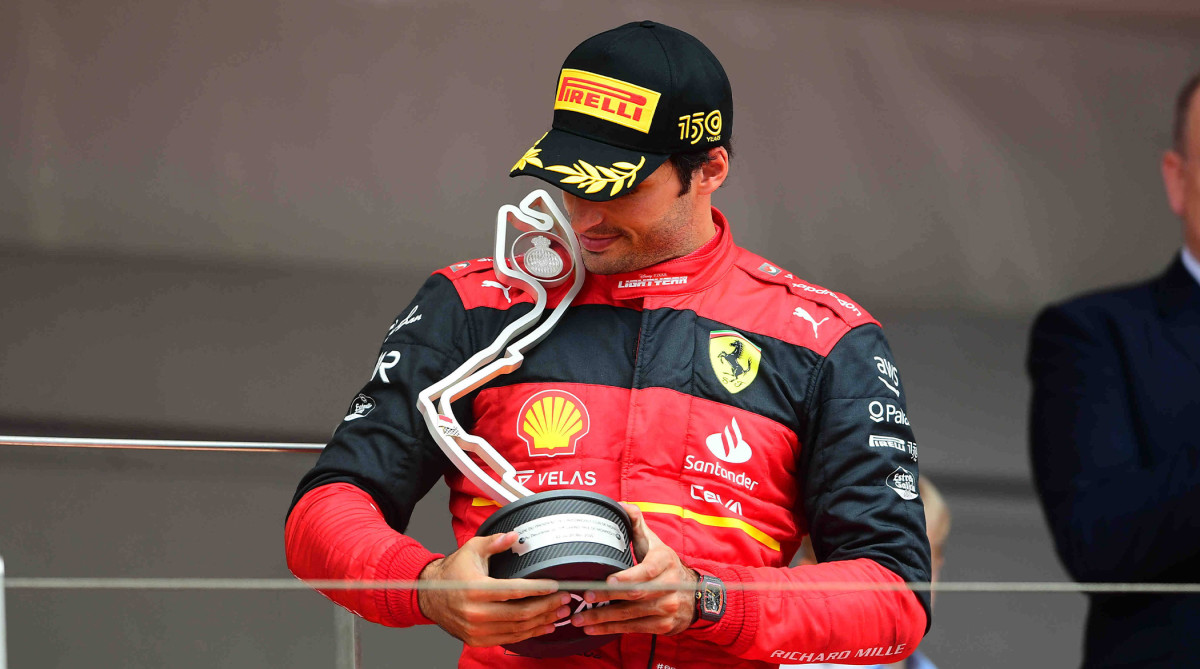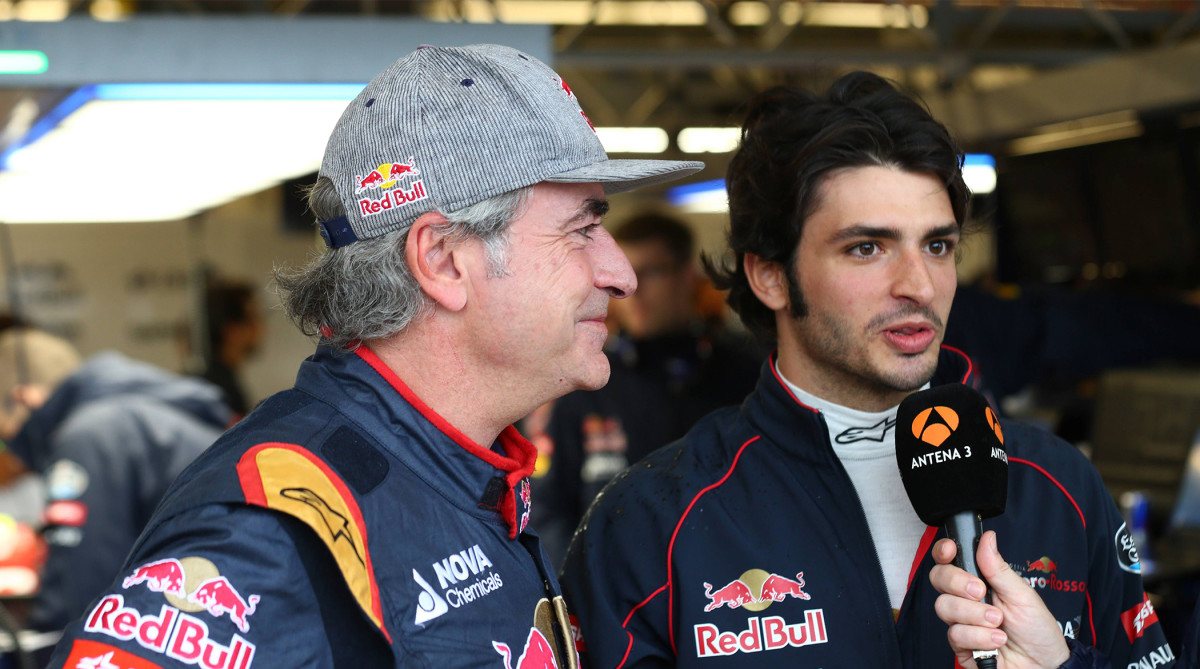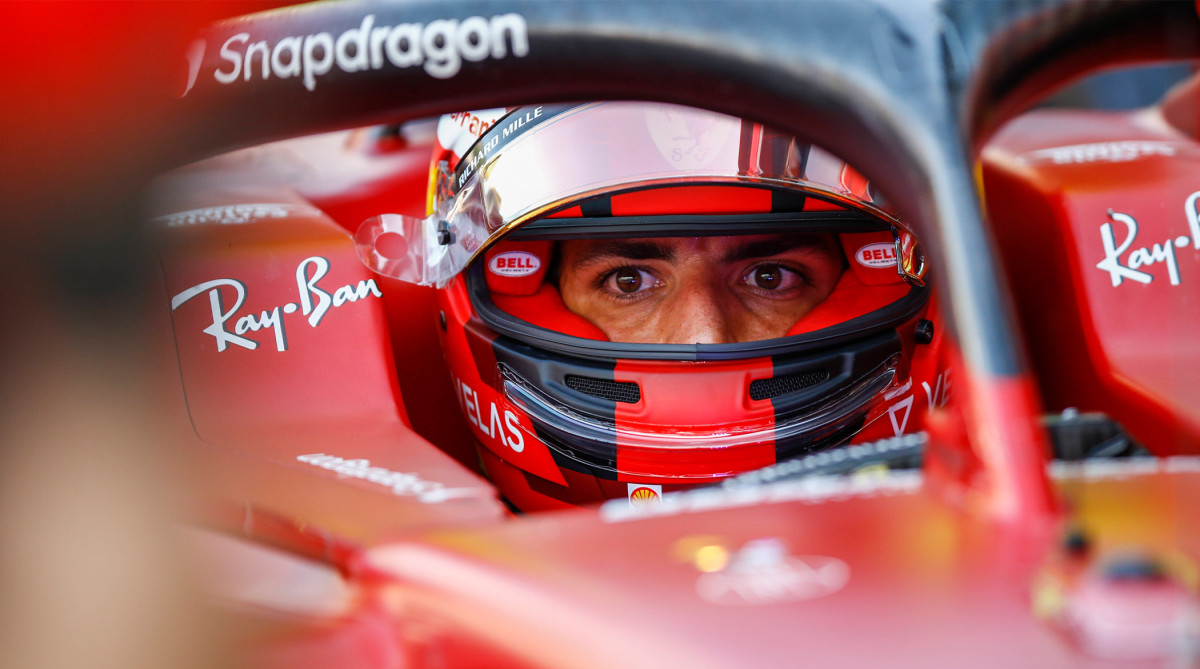Carlos Sainz Faces Pressure in Rise From ‘the Son of’ to F1 Star

Heavy rain poured down on Monaco ahead of the Formula One Grand Prix, soaking fans, teams, drivers and the iconic street track.
After an hour-plus delay, the drivers were finally off, racing against the clock as red flags riddled the crown jewel. They sought dry lines, trying to find grip. Monaco is widely known as a track where overtaking is incredibly difficult given the tight quarters between the barriers. With heavier cars thanks to new technological regulations this season, it proved to be a difficult feat and the rain didn’t help.
Carlos Sainz came barreling past the pit straight, looking to possibly overtake Sergio Pérez. But his Ferrari F1-75 found a wet part of the track, and instinct kicked in as his rear started to slide. The Sky Sports announcers said, “His dad’s rally experience came in there for him,” and described it as “the save of the season.”
But, that’s Sainz’s natural ability after growing up around racing; it’s why he says “engines, tires, gasoline is in my DNA, in my veins.”
Sainz has emerged as a hustler, pushing his car to the edge with a calm temper—showing flashes of his parents. His methodical approach was influenced by the advice from the two-time World Rally champion while his calm temper and empathetic nature came from his mother’s advice. And there was an era he may have been too nice on the grid, his rivals bumping him off the track in his early teenage years.
His father’s advice? Look, in this sport, you either bite or you get bitten. So start biting.
Eight years, 147 F1 races, 10 podiums—Sainz has made a name for himself, emerging from the era during his karting years of being referred to as “the son of Carlos Sainz.” He may come from racing royalty, but it hasn’t been easy for the “normal kid from Madrid.” He had to find his footing, make it past the make-or-break moment many athletes face and navigate a multitude of teams to land at a powerhouse like Ferrari.
And even with a competitive car, Sainz is still finding his rhythm.
“This season—it’s a tricky one. Let’s say so far this season, I haven’t had a race that I feel particularly proud of.”

Believe it or not, Carlos Sainz Sr. was not the one who gave his son his first car.
The double World Rally champion came home one day to his 2-year-old zipping around the driveway in a battery-powered car, drifting and spinning it like a natural. Sainz Sr. asked, who taught his son how to do the tricks? Who put him in the car? Carlos’s godfather, Juanjo Lacalle, had given the eventual Ferrari star his first car.
“I could barely walk, but I could drive a car,” Sainz says. “And I think it has to be part of something inside of us.”
The young driver had big shoes to fill throughout his career, starting with overcoming the doubt and shadow of his star father. Nicknamed El Matador, Sainz Sr. became racing royalty in Madrid as he took the World Rally Champion title twice and finished runner-up four times in his storied career. He has recorded more starts in the series than any other driver, eventually retiring from WRC in 2004 before his son began racing.
The following year, Sainz entered the go-karting circuit, and while this is the entry level for motor racing, he was synonymous with his father. He compared his experience to what it will be like for Tom Brady’s sons if they follow in their father’s footsteps.
“Every kid and every father on the teams that you’re competing against are gonna have an eye on you to see how he’s doing, no? And how this little guy, the son of Tom Brady, is doing in every football competition,” Sainz says. “I felt the pressure from 10 to 15 years old. All of a sudden you’re competing, you’re doing all these go-kart races and you feel like everyone wants to beat you. Everyone is looking at how you’re doing. You don’t have a name. You are the son of Carlos Sainz.
“You’re not Carlos Sainz. You’re the son of, the son of, the son of. They say, ‘The son of Carlos Sainz has done a mistake. He’s not good. He’s just there because of his father.’”
But as he rose through the ranks, the young Spaniard started making his own name and saw the positives. “He gave me so much good advice on so much from his own experience from being a double world champion that you cannot buy,” Sainz says. “So I would much rather take the, let’s say, the bad things for the good things than otherwise.”
Most would have expected him to follow his father’s steps into the rally world, where Sainz Sr. still competes from time to time, most notably in the Dakar Rally. But another driver also captivated Carlos’s attention growing up—Fernando Alonso, who won the Formula One World Championships in 2005 and ’06 with Renault. Carlos went to his first F1 race at 10 years old, and the sport was easier to watch on TV compared to the rallies.
“Although rallies were huge in Spain back then because of my dad, I fell in love with Formula One, and I told my dad that I wanted to be a Formula One driver.”

A make-or-break moment changed the trajectory.
Toward the end of the 2013 season, Sainz was competing in the GP3 circuit, and while he had success, he says he needed to win the following campaign if he wanted any chance to make it to Formula One. “It was probably my last chance to actually make it to Formula One,” he says.
Sainz drastically changed his approach to the sport, not just in racing aspects but also in his behavior. “This was the basics of who I am today, this change in approach that I did that year.”
Now, don’t get him wrong—it was not that the Spaniard was not trying. He says he thought he was preparing himself, paying attention to detail and forming his methods. But during the winter season before 2014, Sainz started reviewing his approach.
“I actually saw that I could do a lot more. I thought I was doing a lot, but then I realized it actually is not that much. If this is my passion and this is my work, I can actually do a lot more.”
Twenty years, six months and 14 days.
A decade after taking his first steps in go-karts, Sainz made his F1 debut in 2015. But he did more than just start—he finished ninth in his very first race, taking home points from Melbourne for Toro Rosso (now known as AlphaTauri). And the rest was history.
He stayed with Toro Rosso until 2018, making the leap to Renault before replacing his childhood hero, Alonso, at McLaren a season later. He snagged his maiden F1 pole in 2019 at Brazil, and he’d go on to bring home another for McLaren in 2020 from Monza. Sainz may have only tallied two podiums over two seasons with one of the most historic teams on the grid, but he caught the eye of Ferrari as he became competitive in the midfield.
Over the years, he’s learned that this is one of the sports that “depends a bit less on the athlete.”
“There’s so many other factors that come into play inside the sport. There’s the machinery, there’s so many people involved in the sport, there’s an hour-and-a-half-long race, pit stops, strategy calls. It’s a very complex sport to actually nail everything,” Sainz says. “And you as an athlete might be doing a great job, and then suddenly, there’s one day that you have a puncture and you DNF, and you don’t finish the race and it’s a zero and you were doing a great job. The same way that one day you might actually be suffering a lot on track and not having a great day, but two people in front of you retire with issues and then you go on to a good result.”
While he may have four podium finishes this season, including finishing second in Monaco, the 27-year-old also recorded two consecutive DNFs in Melbourne and Imola. He said before Monaco that “this season there’s nothing really that has clicked exactly for me, and there is not one race that I would say I’m 100% proud of. I’m quite demanding with myself and I know when I’ve given 100% and when I’ve done 100% out of the car and myself. Six races into this season, I wouldn’t say I have done one of those yet.”

Cameras clicking, team members chatting and fans calling drivers’ names echo in and out of the paddock, swarming the stars as they make their way to the hospitality suites or the garage. Fans lean over the barriers to get the drivers’ attention for an autograph, others step in their way to try to snag a photo.
There’s pressure beyond what happens behind closed doors for these drivers, and it follows them off the track. While they can ignore the hate that comes on social media, fans often stop the drivers in the street for selfies during their off time, whether they know who the driver is or not.
Sainz wishes people would pause and ask, how are you?
“There’s too many superficial approach nowadays with the phone and just because five people want to take a picture with me, doesn’t mean that just because I’m famous you want to take a picture with me,” Sainz says. “Instead of doing that, come and ask me like, why are you famous? Like what do you do? And I will very happily answer that I drive for Formula One, and that’s why people are taking a picture but you don’t want a picture with me because you don’t know who I am. Just say hello to me. Say, ‘Oh great. I will be following you from now on and nice to meet you.’
“This would make my day because there’s so many people that actually don’t know you, that just because they think you’re famous, they come and take a picture for their Instagram and then they send [to] their friends. But they don’t realize how sometimes painful it is to take another, another, another, another selfie, another selfie with people that maybe don’t even know who you are.”
Who is Carlos Sainz?
“I’m just a normal kid from Madrid, Spain, that just enjoys being a Formula One driver. … I consider myself very lucky to first make it to Formula One, then going through different teams to manage to make it to Ferrari. And now actually having a competitive car to be able to fight for podiums and wins in Formula One, which is a dream come true. But the biggest dream is still to be achieved—that is to be a Formula One champion.”
More Formula One Coverage:
